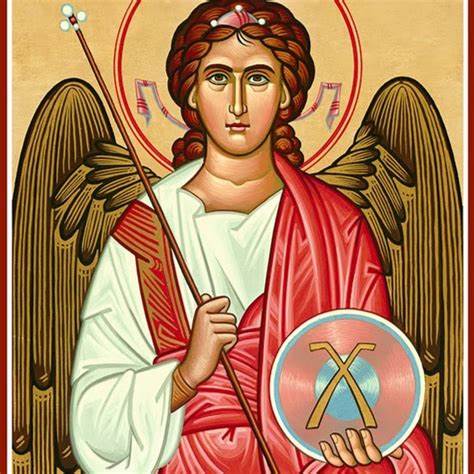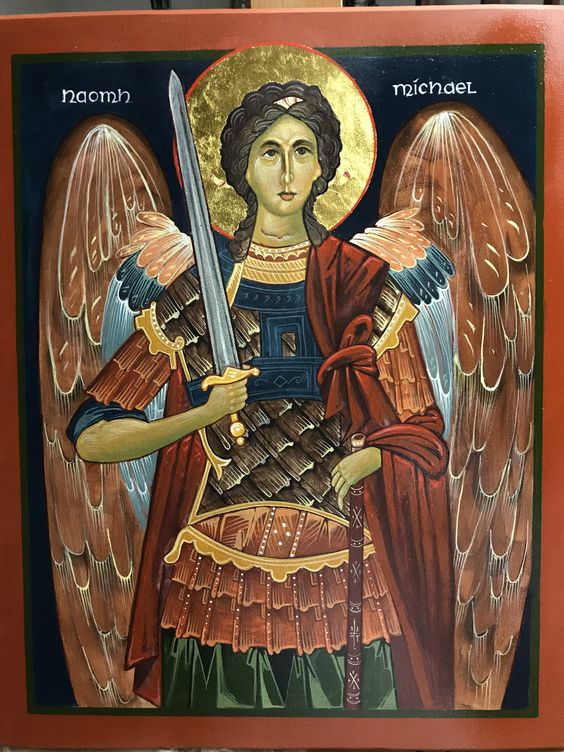The Archangel Michael and the Rite of Exorcism
“Who maketh his angels spirits; his ministers a flaming fire.” Psalm 54:4
 Psalm 54 advises us that the Creator made his angels spirits, and his ministers flames of fire. In Biblical tradition, these sinless, invisible beings are among us in their hundreds of thousands, simultaneously serving God on both earth and in heaven. According to the Psalm, the angels inhabit and harmonise the elemental form of nature, the everyday and ordinary matter all about us. They do so in order to balance opposing forces that would otherwise make life on our planet impossible, through their presence in the four classical elements of wind, earth, fire and water. In short, the Bible is explaining the core principles of the multiverse of modern quantum physics, where particles split off to create separate parallel worlds. It is another way of describing the spiritual realm as a dimension interwoven with our own, populated by a myriad of beings that are somehow present in the baser elements that comprise our reality. Hence the words of the canticle Benedicte, omnia opera Domini in the monastic Liturgy of Hours, which finds repetition in numerous contemporary esoteric orders:
Psalm 54 advises us that the Creator made his angels spirits, and his ministers flames of fire. In Biblical tradition, these sinless, invisible beings are among us in their hundreds of thousands, simultaneously serving God on both earth and in heaven. According to the Psalm, the angels inhabit and harmonise the elemental form of nature, the everyday and ordinary matter all about us. They do so in order to balance opposing forces that would otherwise make life on our planet impossible, through their presence in the four classical elements of wind, earth, fire and water. In short, the Bible is explaining the core principles of the multiverse of modern quantum physics, where particles split off to create separate parallel worlds. It is another way of describing the spiritual realm as a dimension interwoven with our own, populated by a myriad of beings that are somehow present in the baser elements that comprise our reality. Hence the words of the canticle Benedicte, omnia opera Domini in the monastic Liturgy of Hours, which finds repetition in numerous contemporary esoteric orders:
"O all ye works of the Lord, bless ye the Lord; praise him and magnify him for ever.
O ye angels of the Lord, bless ye the Lord; praise him and magnify him for ever.
O ye heavens, bless ye the Lord; O ye waters that be above the firmament bless ye the Lord;
O all ye powers of the Lord, bless ye the Lord; praise him and magnify him for ever.
O ye sun and moon, bless ye the Lord;
O ye stars of heaven, bless ye the Lord."
Science is good at classifying nature and applying its laws to bend to our will - such as in the treatment of illness, or giving us the gift of machines that carry us at high speed on land, water and in the air. In this we enjoy the free use of God’s gifts, but through imposing our will on the elements we have also unleashed weapons of mass destruction and ruined our planets atmosphere. Yet the abuse of something does not supersede the use of it, since we have a sacred duty to advance knowledge in the spirit of humility.
illness, or giving us the gift of machines that carry us at high speed on land, water and in the air. In this we enjoy the free use of God’s gifts, but through imposing our will on the elements we have also unleashed weapons of mass destruction and ruined our planets atmosphere. Yet the abuse of something does not supersede the use of it, since we have a sacred duty to advance knowledge in the spirit of humility.
In the last resort, the etheric force comprising the vitalism (life) in all living beings is explainable by the presence of these unseen, invisible intelligences within nature. These intelligences are the angels (God’s fiery ministers) housed within elemental matter. As the psalmist says, God made them from spirit and fire. These substances are the fiery-waters of the prima materia, that which vibrates throughout the cosmos and is able to enter and harmonise the baser elements of which our universe is comprised. The examples are myriad, but let us consider a few, remembering always that there is an allegorical meaning to the stories. In the Gospel of John, we read that an angel gave the pool at Bethesda its healing properties, which is to say the angel was an elemental of water:
“For an angel went down at a certain season into the pool, and troubled the water: whosoever then first after the troubling of the water stepped in was made whole of whatsoever disease he had.” (John 5:4)
 We are reminded here of the angel of elemental fire, present in the burning bush appearing before Moses in Exodus. The Angel appeared in flaming fire, but the bush was not consumed by it. When Moses tried to approach, the angel was no longer called the “Angel of the Lord,” just “Lord.” The word angel (Greek: angelos; Hebrew: malok) means “messenger.” One suggestion is that when Moses beheld the angel in the flaming fire he may have seen the preincarnate Logos, or Son of God. Indeed, Christ takes the appearance of a fiery messenger when he appears before St. John the Divine in the Apocalypse:
We are reminded here of the angel of elemental fire, present in the burning bush appearing before Moses in Exodus. The Angel appeared in flaming fire, but the bush was not consumed by it. When Moses tried to approach, the angel was no longer called the “Angel of the Lord,” just “Lord.” The word angel (Greek: angelos; Hebrew: malok) means “messenger.” One suggestion is that when Moses beheld the angel in the flaming fire he may have seen the preincarnate Logos, or Son of God. Indeed, Christ takes the appearance of a fiery messenger when he appears before St. John the Divine in the Apocalypse:
“His head and his hairs were white like wool, as white as snow; and his eyes were as a flame of fire.” (Rev. 1:14)
The angel that destroyed 185,000 soldiers in the Assyrian army of king Sennacherib (2 Kings 19:35) was presumably an elemental of wind, since they were all killed in their sleep. The angel of death (“the Destroyer”) passing over Egypt in Exodus 12:12-13 is the entity we encounter again in 2 Samuel:
“And when the angel stretched out his hand upon Jerusalem to destroy it, the Lord repented him of the evil, and said to the angel that destroyed the people, It is enough: stay now thine hand. And the angel of the lord was by the threshing place of Araunah the Jebusite.” (2 Sam. 24:16)
If you think about it, the four horsemen of the Apocalypse allegorise the presence of these supernatural![]() beings as forces in nature. They appear when the Lamb of God opens the first four of the seven seals and summons the angels of “the four winds” (the four cardinal directions) to do God’s work. These are the archangels Michael, Gabriel, Raphael and Uriel, who ride out on white, red, black and pale horses to inflict vengeance on a depraved society. They remind us of the Destroyer as he appears in 1 Chronicles, where king David saw the angel of the Lord stand between heaven and earth “with a drawn sword in his hand stretched out over Jerusalem.” (1 Chron 21:16) David glimpsed beyond the physical senses which ordinarily screen our vision of the spiritual beings about us. It was David’s hubris which caused the pestilence on Israel, and which killed 70,000 men.
beings as forces in nature. They appear when the Lamb of God opens the first four of the seven seals and summons the angels of “the four winds” (the four cardinal directions) to do God’s work. These are the archangels Michael, Gabriel, Raphael and Uriel, who ride out on white, red, black and pale horses to inflict vengeance on a depraved society. They remind us of the Destroyer as he appears in 1 Chronicles, where king David saw the angel of the Lord stand between heaven and earth “with a drawn sword in his hand stretched out over Jerusalem.” (1 Chron 21:16) David glimpsed beyond the physical senses which ordinarily screen our vision of the spiritual beings about us. It was David’s hubris which caused the pestilence on Israel, and which killed 70,000 men.
The forces unleashed are always elemental, like the parting of the Red Sea by the wind and its subsequent crashing down on the army of the pursuing Egyptians. This latter is an allegory of the Divine retribution on the demonic forces present in nature like none other; and which retribution is carried out by the angels and ministers of God who continued to fulfil his commands. It follows that we are told of the existence of angels in the scriptures for a reason, and that seems to be for the purpose of connecting sight of this world with the thought of another. Put another way, God is beyond his angels and ministers, beyond all matter – be it spiritual or elemental – and the role and mission of the angels is to bring about harmony and order on earth for the evolutionary progress of humankind. This evolution, as I have said previously (most recently in my book Son of Perdition: The Magic and Hubris of Simon Magus), runs in both a lineal direction in terms of our physical evolution as animals, but also runs in reverse in taking us back towards the point in time when our group soul was contained in Adam Kadmon, the glorified being who was higher than the lofty angels and whose ministry was to bring the fallen aeons back into obedience to God.
The existence of magic owes its provenance to the operations given to Adam to contain and reconcile these fallen angels, or demons, vestiges of which power remained with man after his Fall. It is easy to abuse either through ignorance or deliberate misuse, but the power of invoking the angels is why the Church joins human praise with that of the angels and archangels.
 As I discuss in Son of Perdition, the reality of magic was not in question in the ancient world. The polemic of the Church was directed instead at the use of black magic to manipulate the fallen angels. A power not included in the seven sacraments of the Church is exorcism. Yet the Rite of Exorcism includes the “Leonine Prayers” of Pope Leo XIII (Vincenzo Pecci, 1810-1903). The invocation of the Archangel Michael is the most prominent part of these prayers. The reason for this is that Pope Leo had a direct experience of demonic forces. In 1884 he composed the prayer to Michael after experiencing a vision of Satan conversing with God over the city of Rome. He ordered the prayers to be spoken after each low mass, and in 1890 added another prayer to St. Michael in the rite of exorcism (the Acta Sanctae Sedis. In Exorcismus in Satanam et angelos apostaticos).
As I discuss in Son of Perdition, the reality of magic was not in question in the ancient world. The polemic of the Church was directed instead at the use of black magic to manipulate the fallen angels. A power not included in the seven sacraments of the Church is exorcism. Yet the Rite of Exorcism includes the “Leonine Prayers” of Pope Leo XIII (Vincenzo Pecci, 1810-1903). The invocation of the Archangel Michael is the most prominent part of these prayers. The reason for this is that Pope Leo had a direct experience of demonic forces. In 1884 he composed the prayer to Michael after experiencing a vision of Satan conversing with God over the city of Rome. He ordered the prayers to be spoken after each low mass, and in 1890 added another prayer to St. Michael in the rite of exorcism (the Acta Sanctae Sedis. In Exorcismus in Satanam et angelos apostaticos).
The rite contains a series of ten conjurations, and the prayer to St. Michael is one of them. It requests “the Most glorious Prince of the Heavenly Army, Holy Michael” to defend the faithful in the battle against the forces of evil and chaos, i.e. “the former angels.” The Church venerates St. Michael as its custodian and patron. I look at this in greater detail in Son of Perdition, but essentially the Roman Rite of Exorcism contains an express command to the demon or demons possessing the victim. The conjurations of the exorcist are evocations of the name of the Archangel Michael and of the Holy Spirit. The command addressed to the evil spirit in the Roman Rite of Exorcism is operative magic, and reminds the infecting entity:
" … the longer you delay, the heavier your punishment shall be; for it is not men you are condemning, but rather Him who rules the living and the dead, who is coming to judge both the living and the dead and the world by fire.”
This reminds us, again, that the world of spirit and the world of nature is entwined with our own. Although veiled from us, nature is the battleground between the forces of chaos and order.
This article is the copyright (c) of M.R. Osborne, 2022






